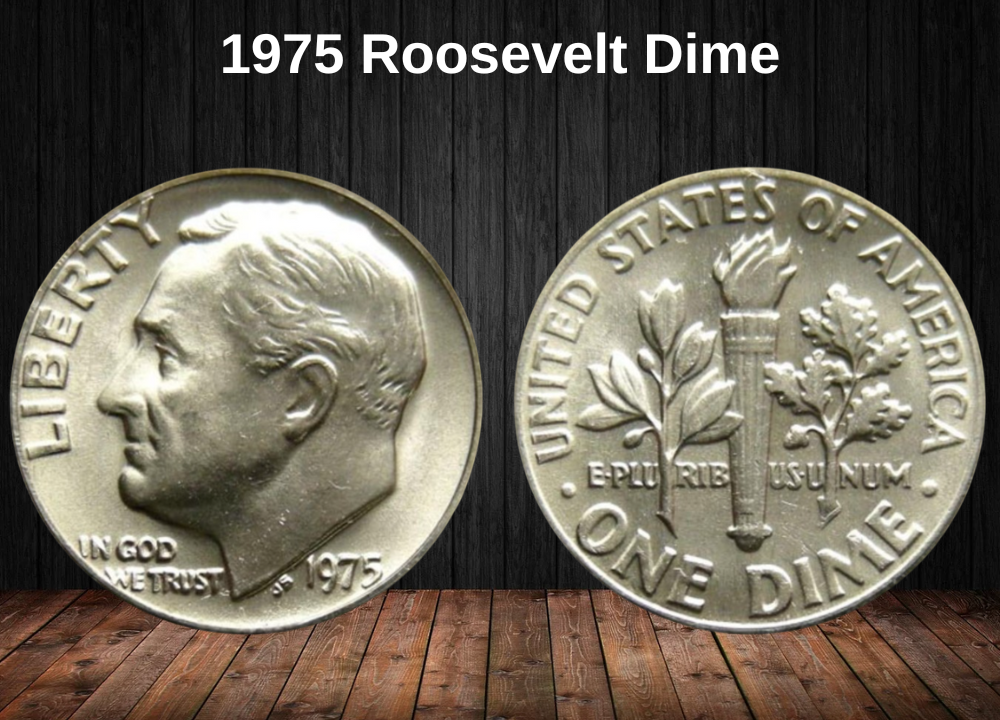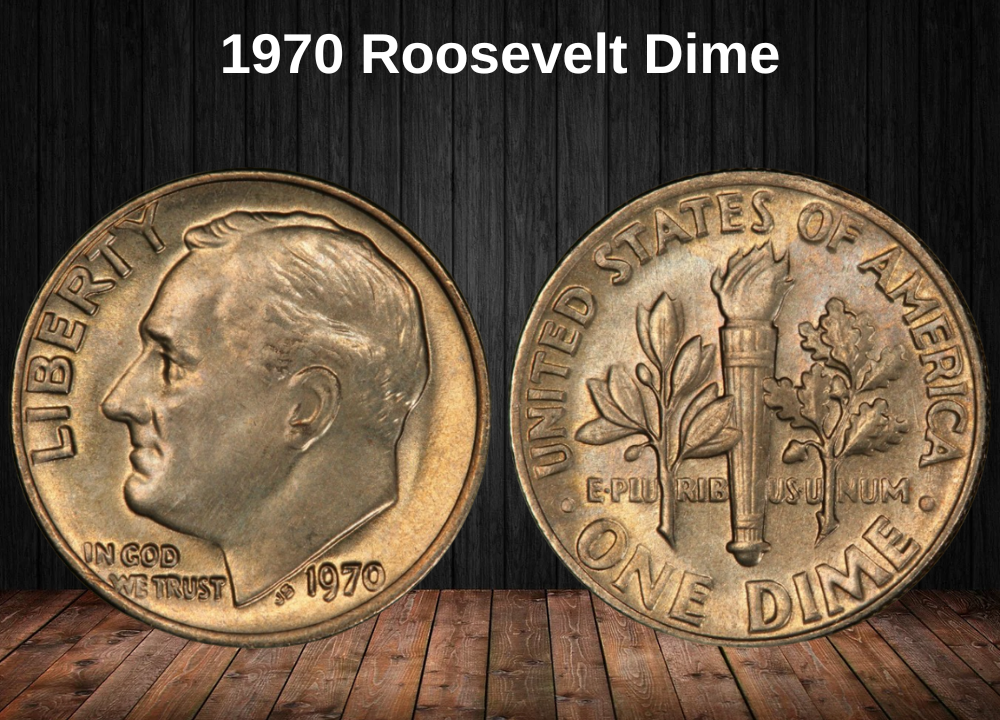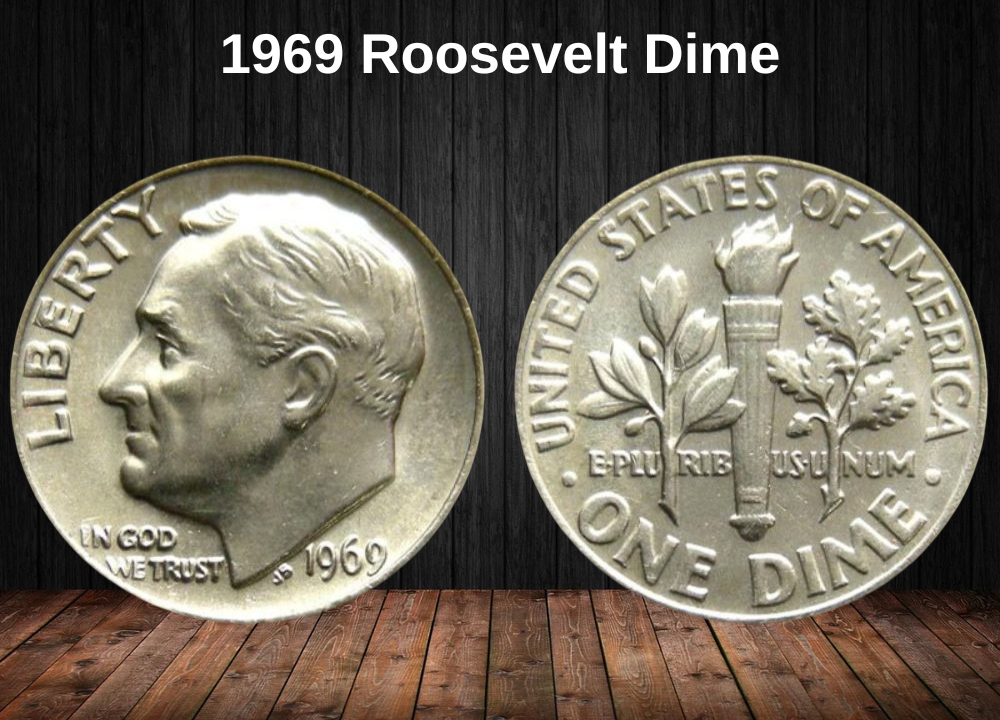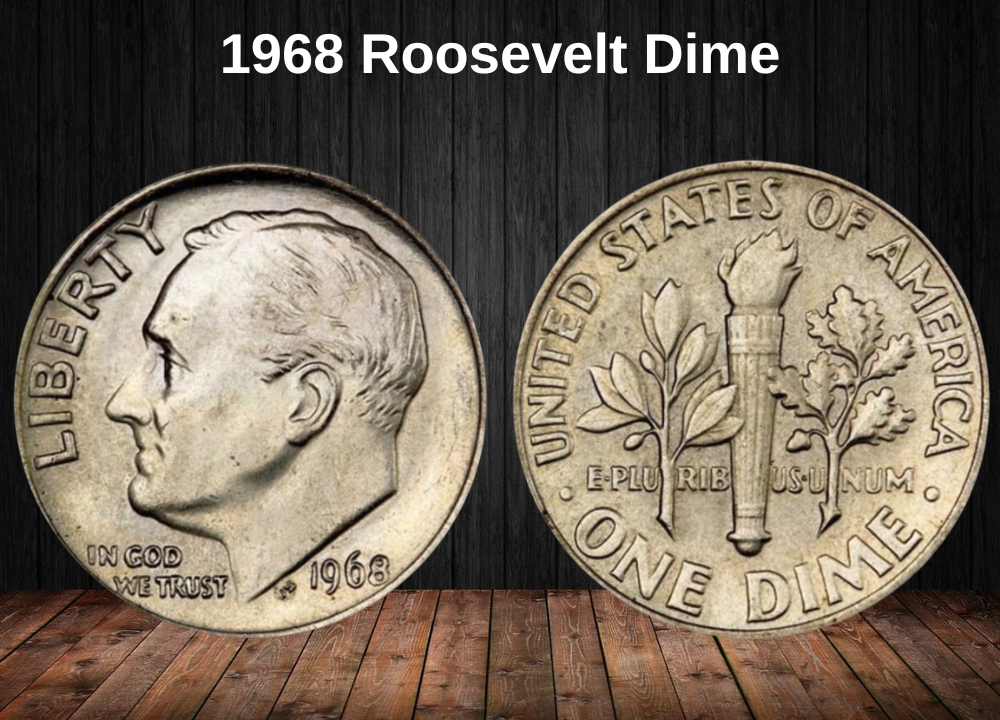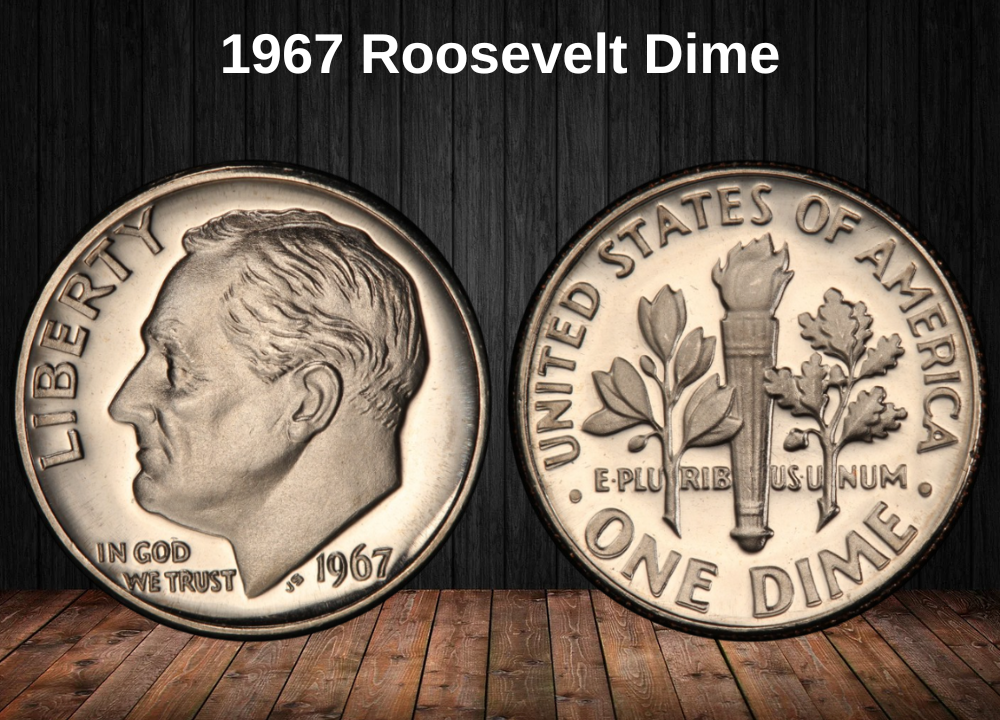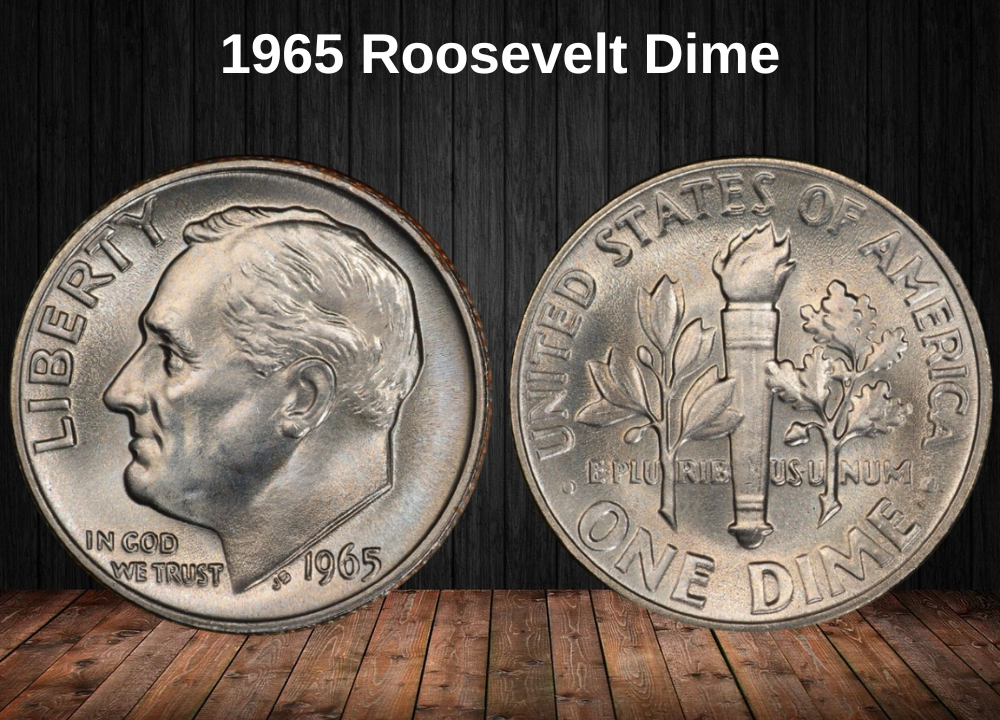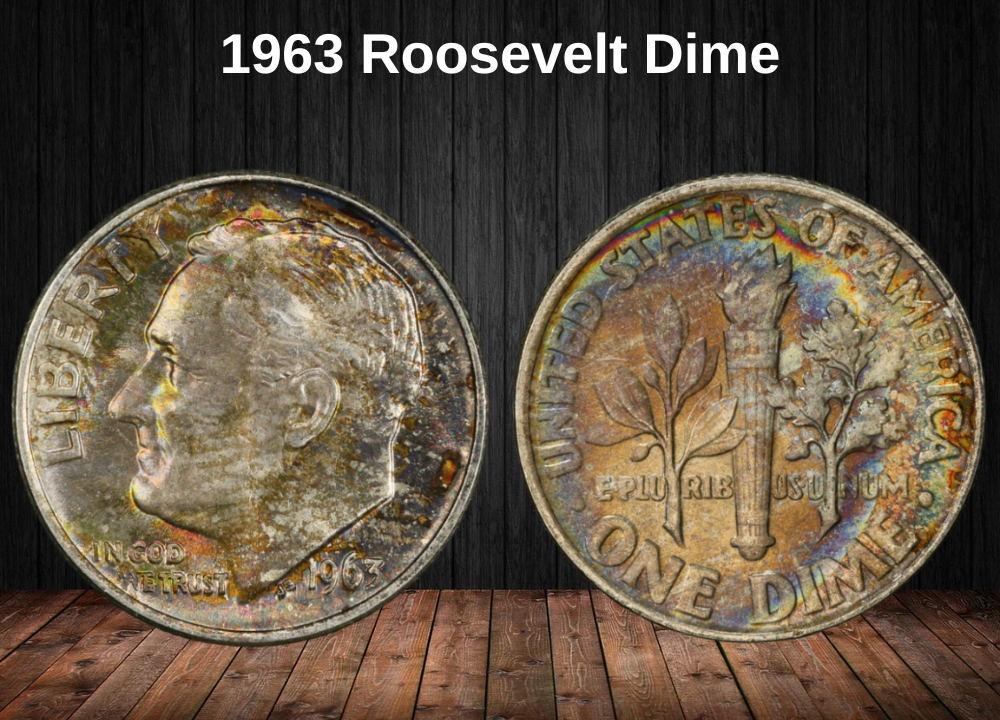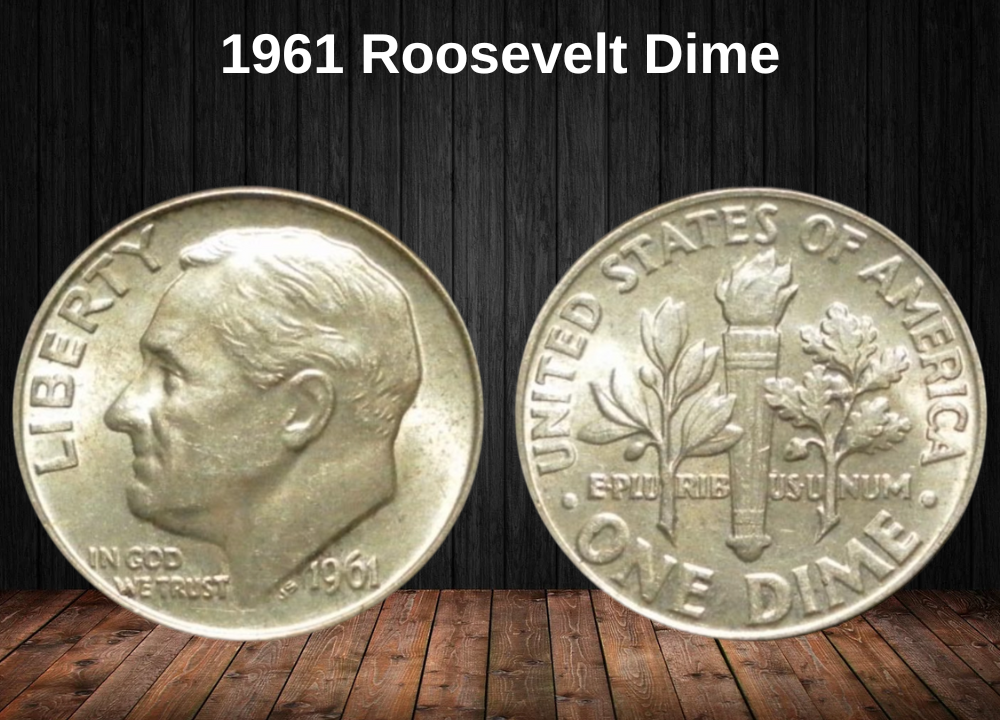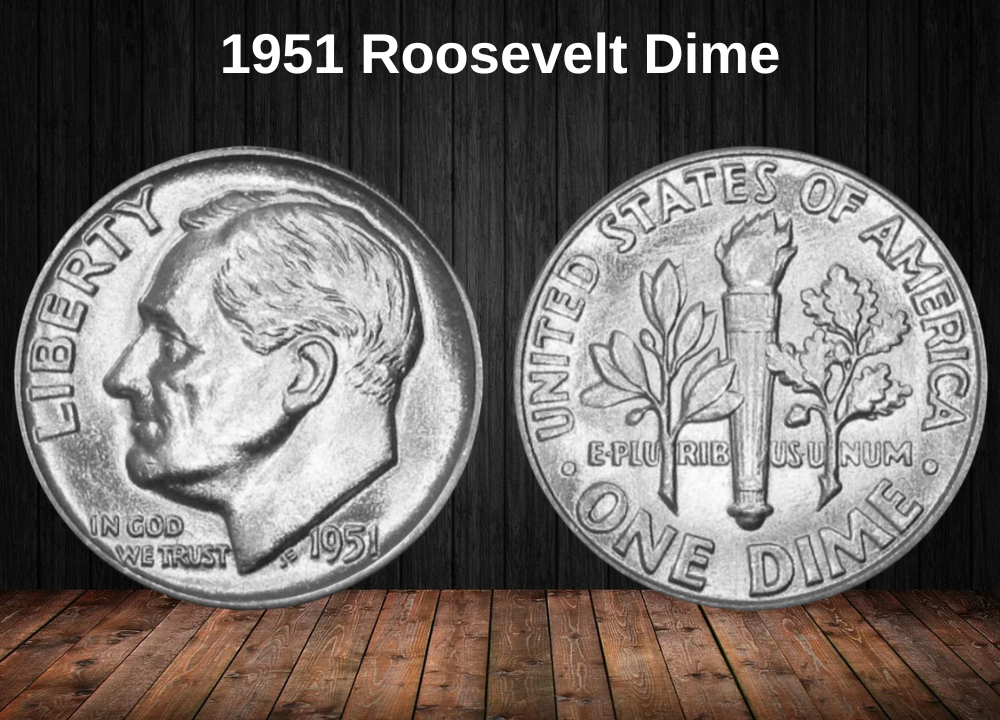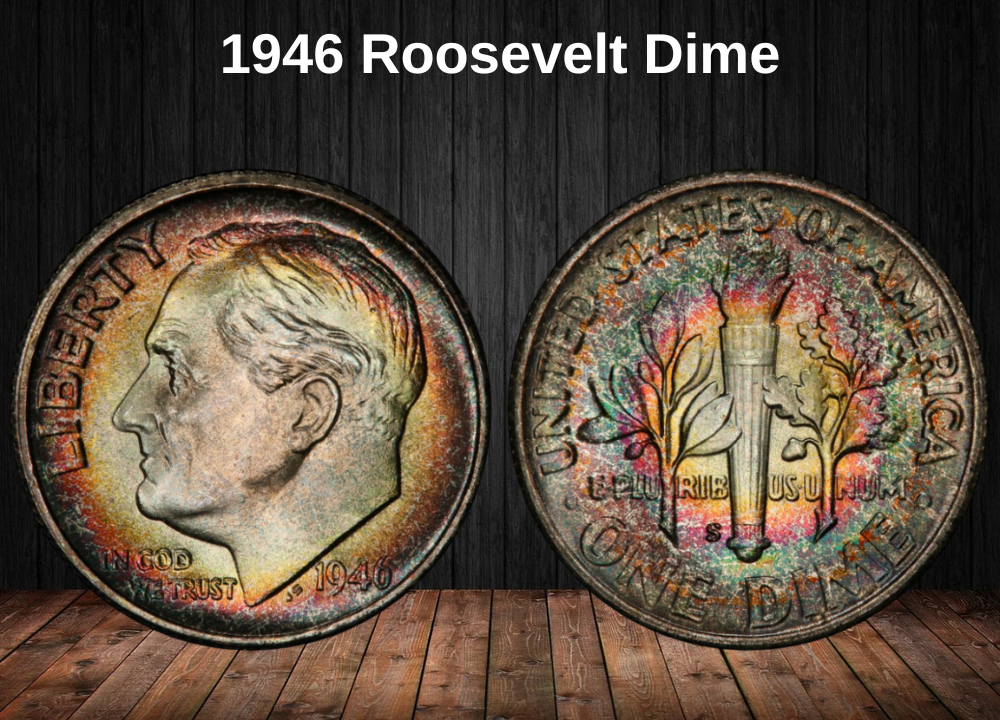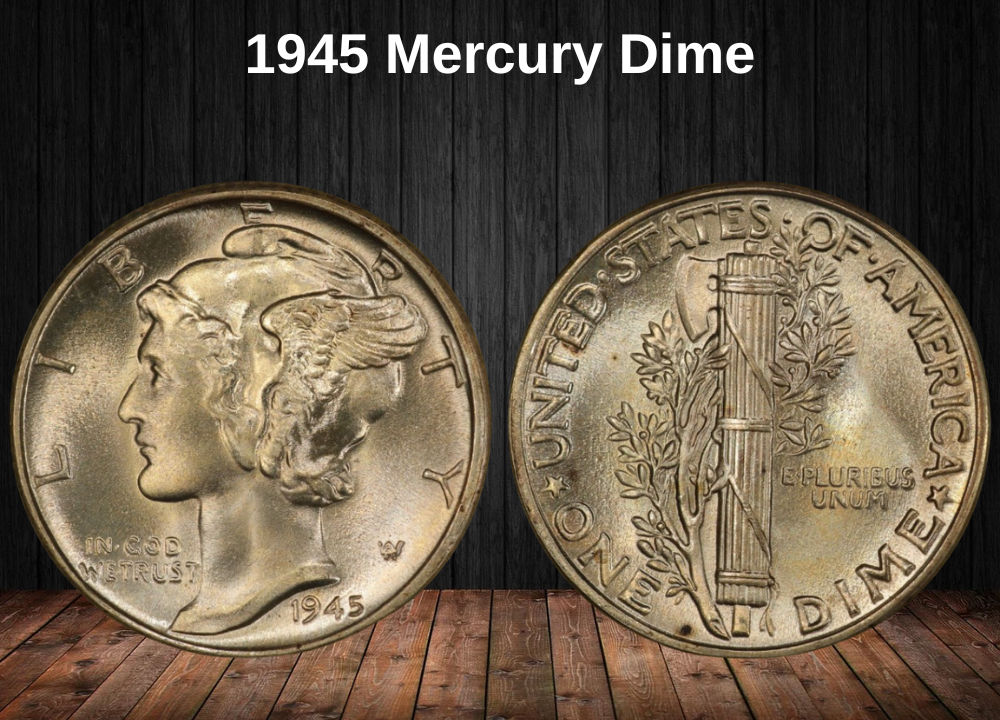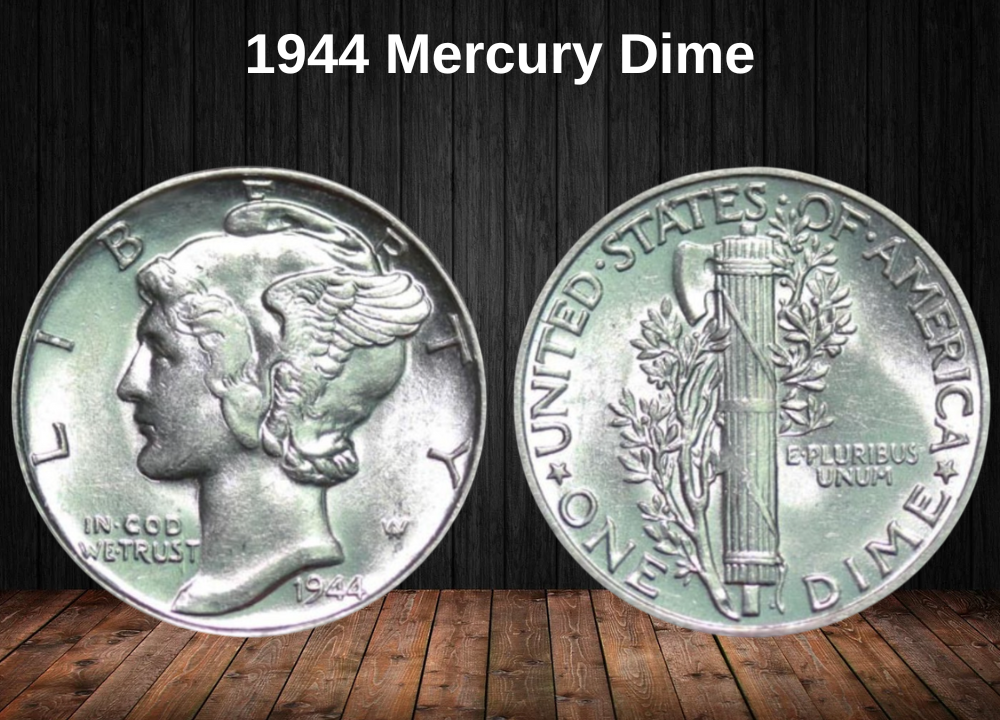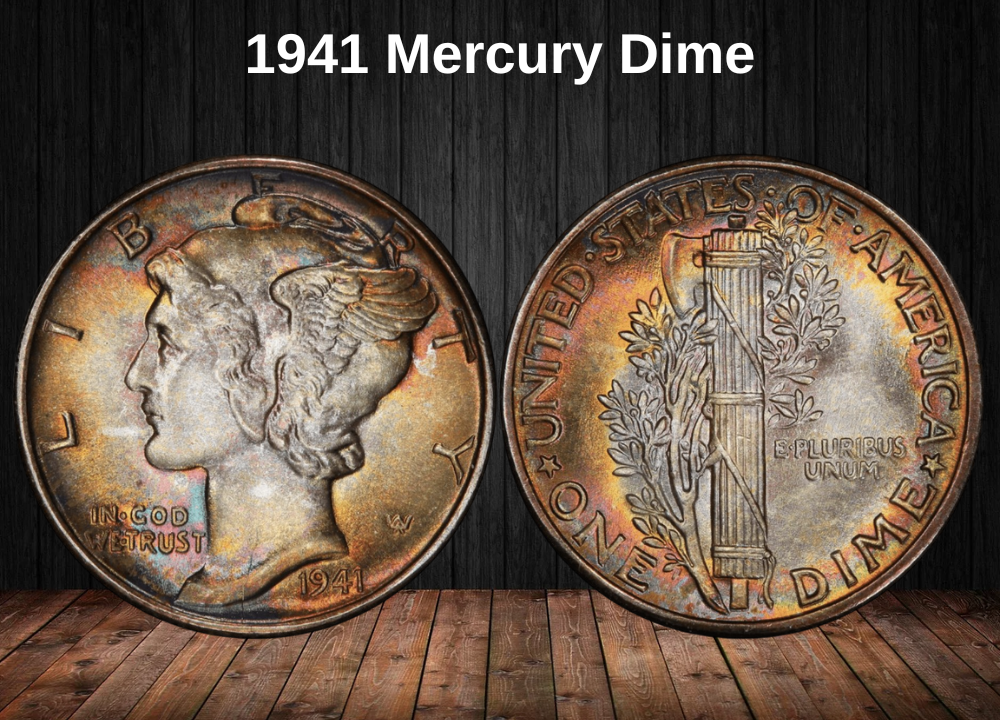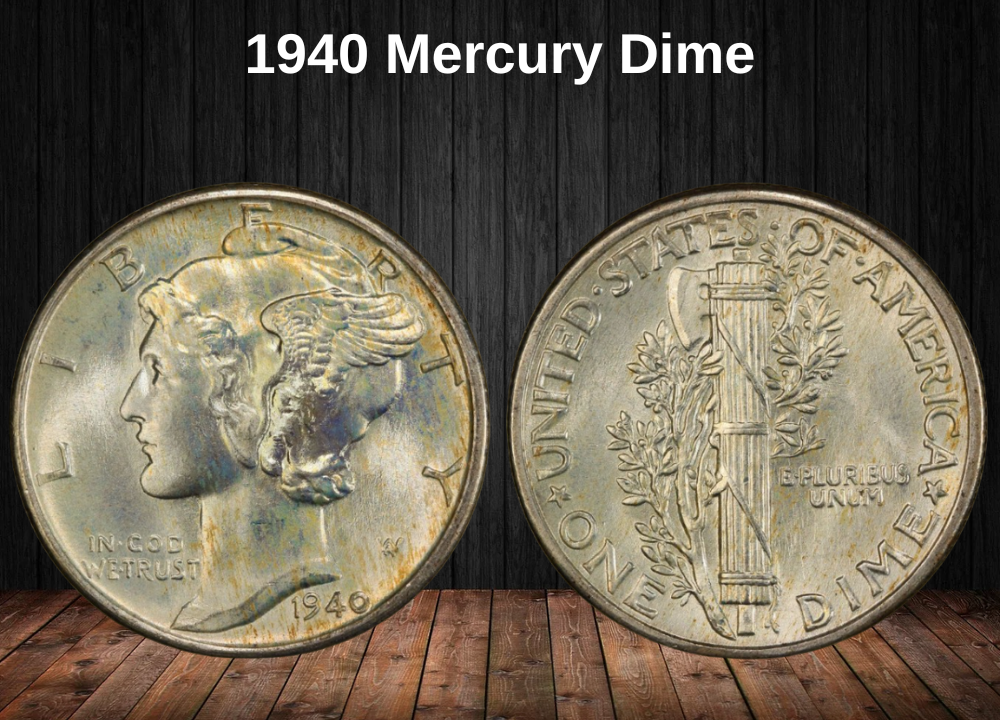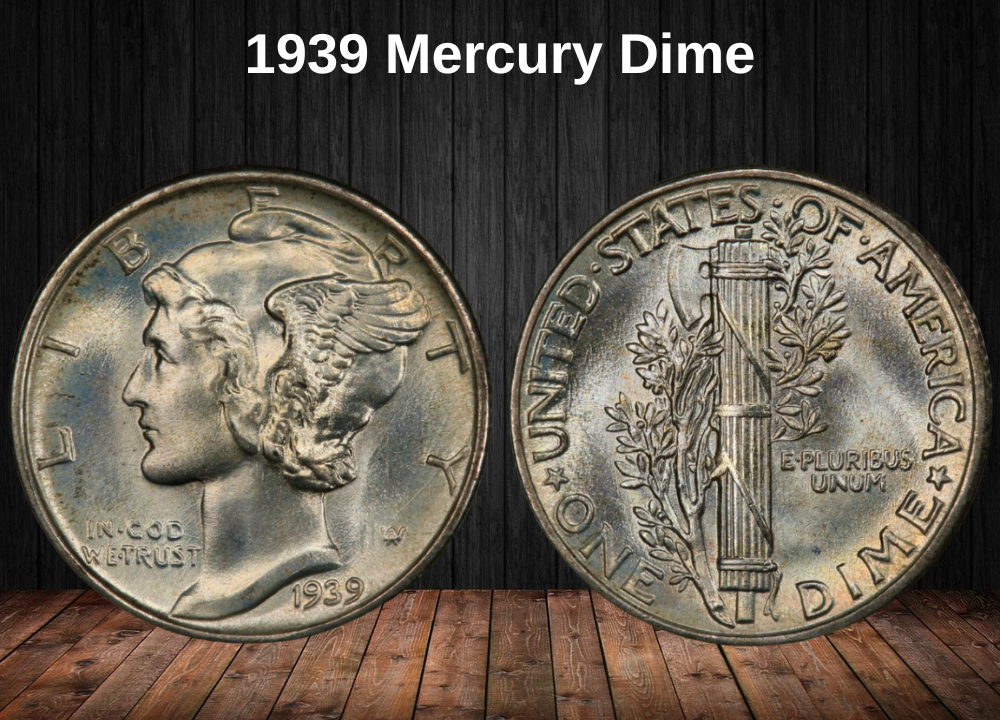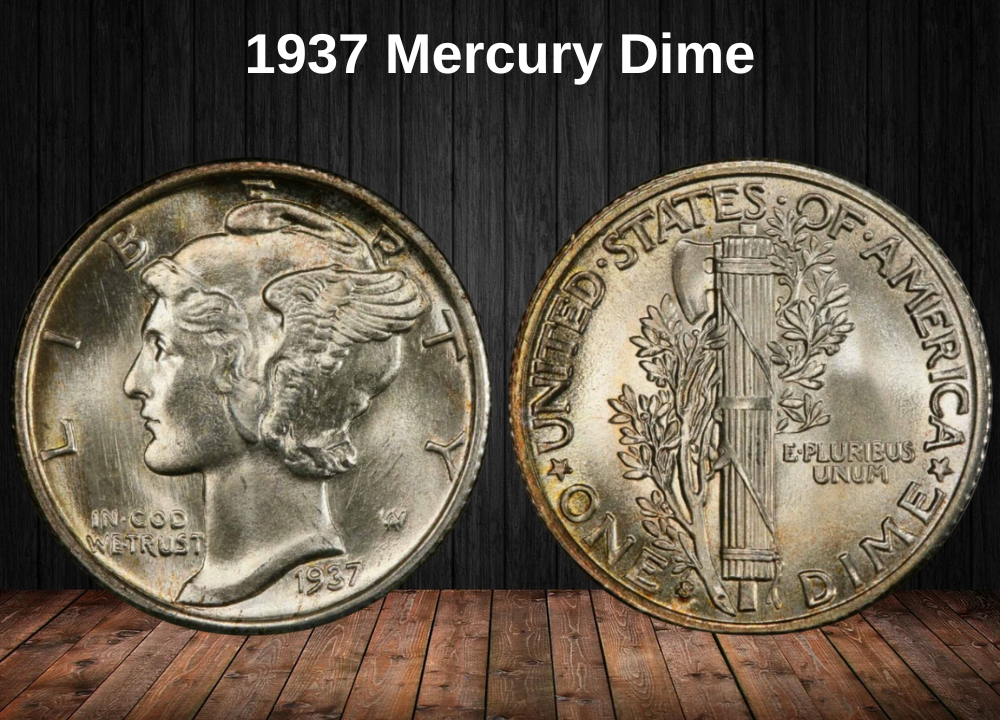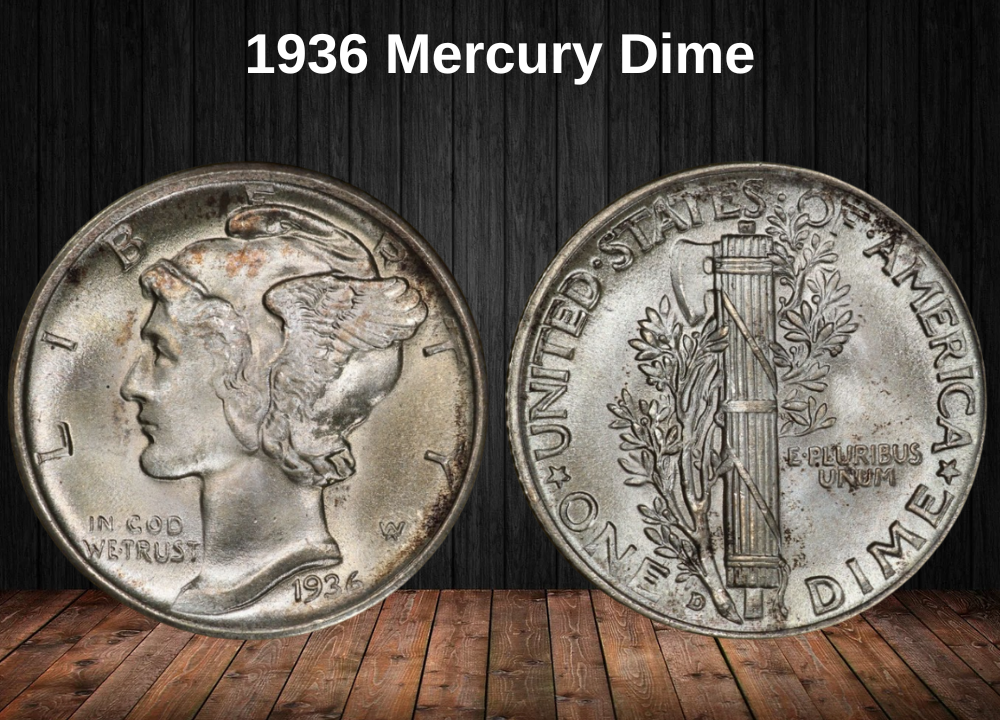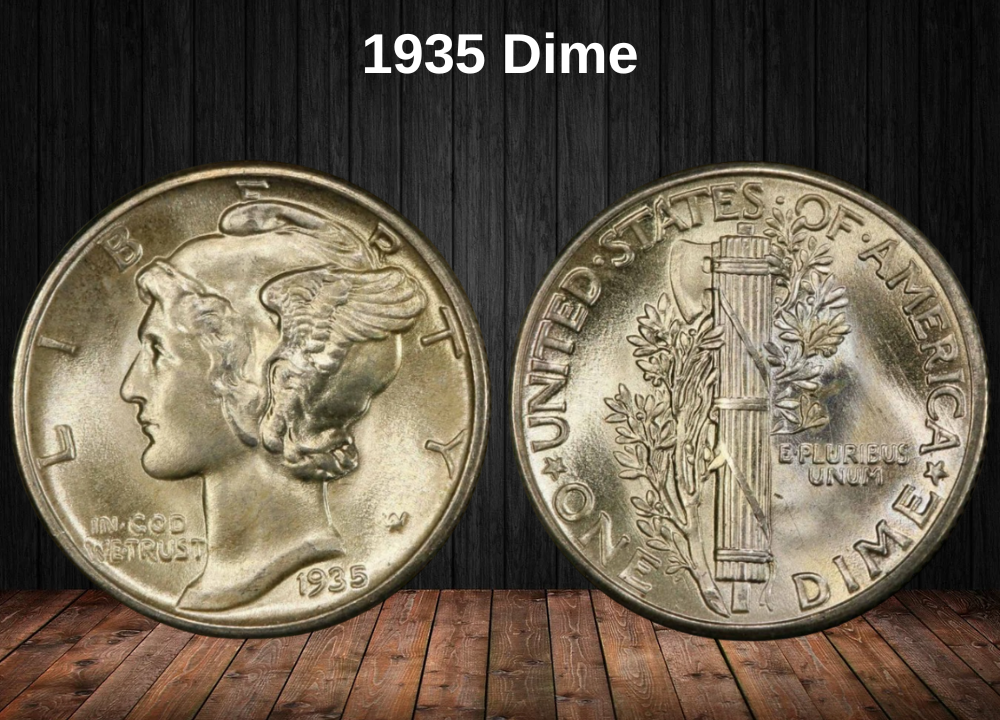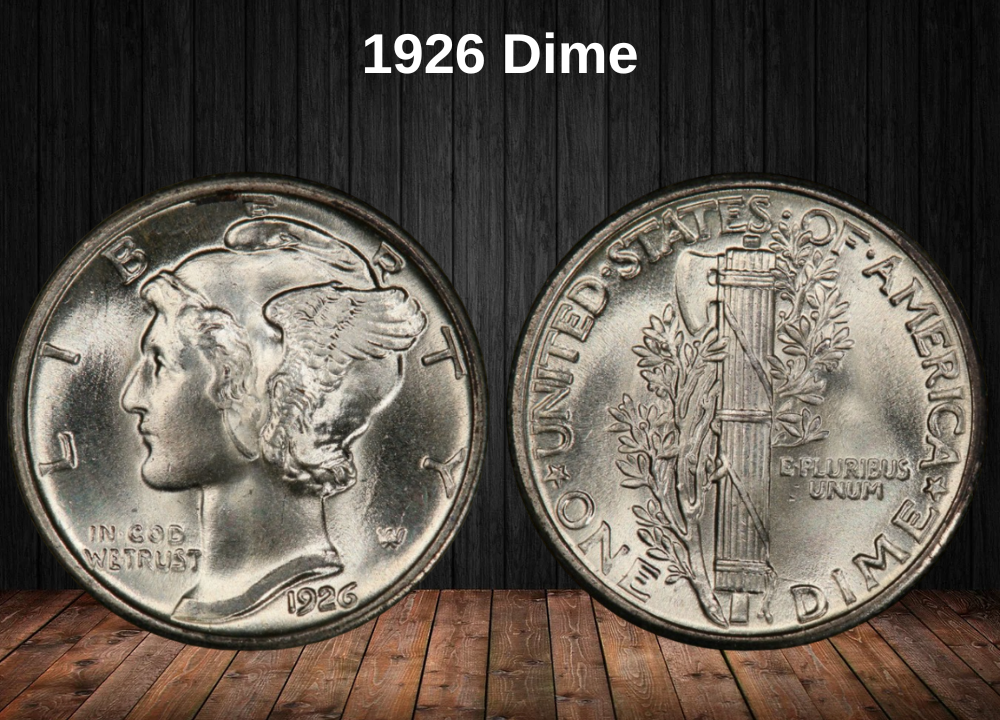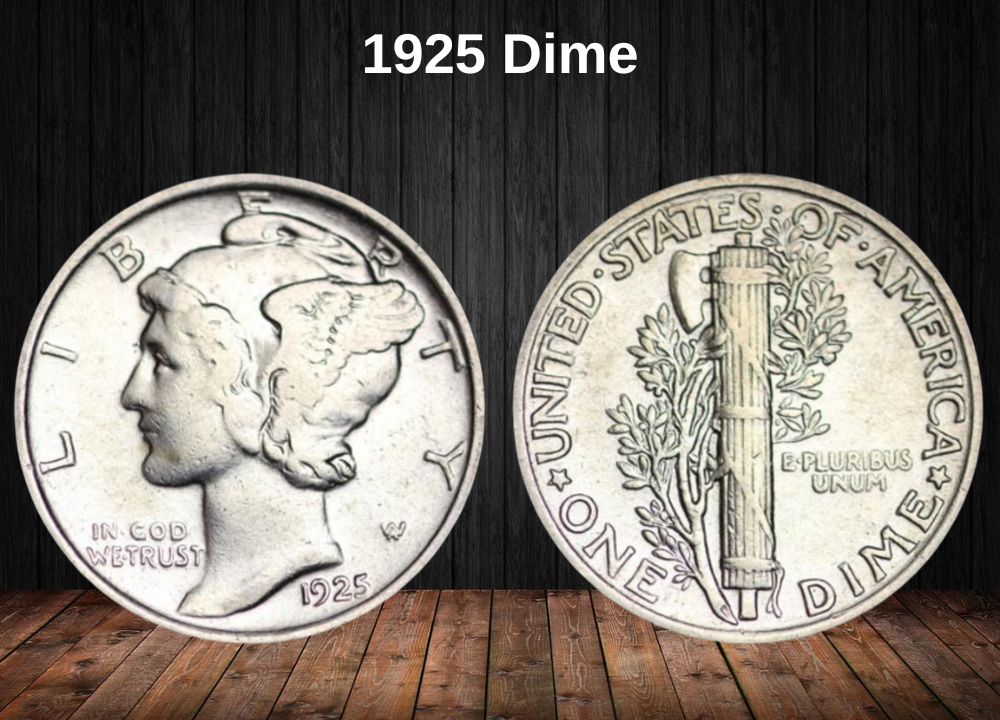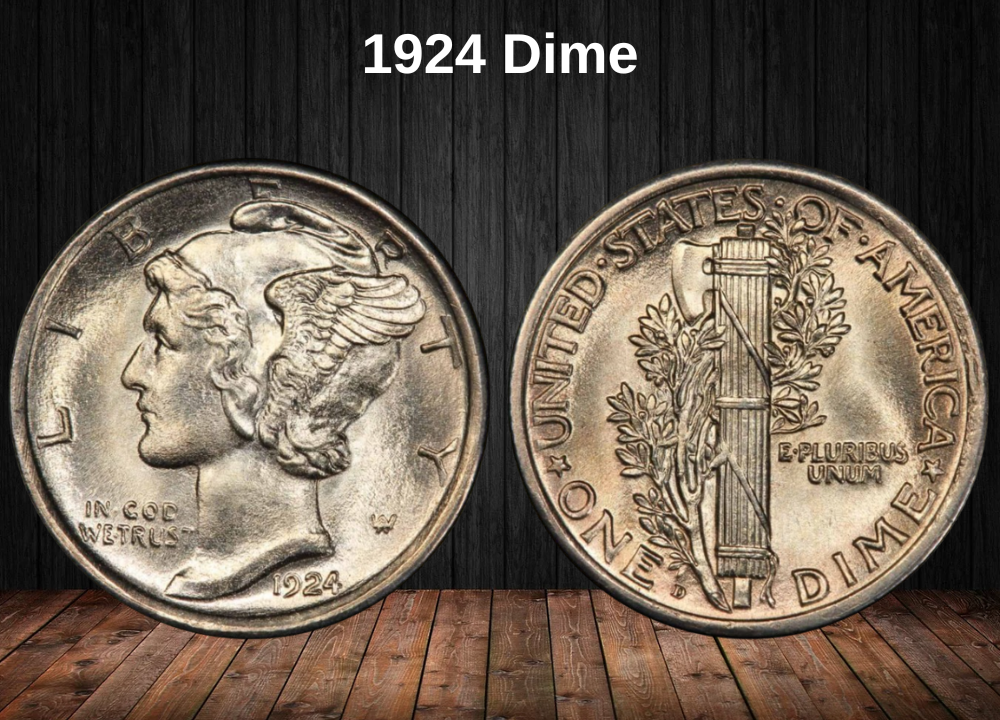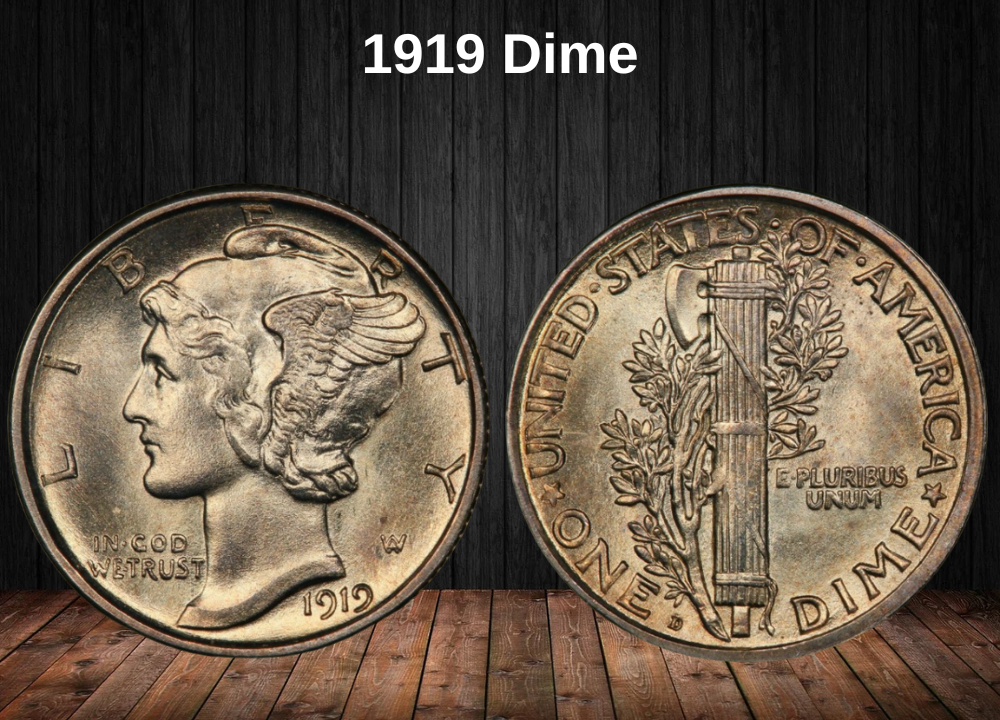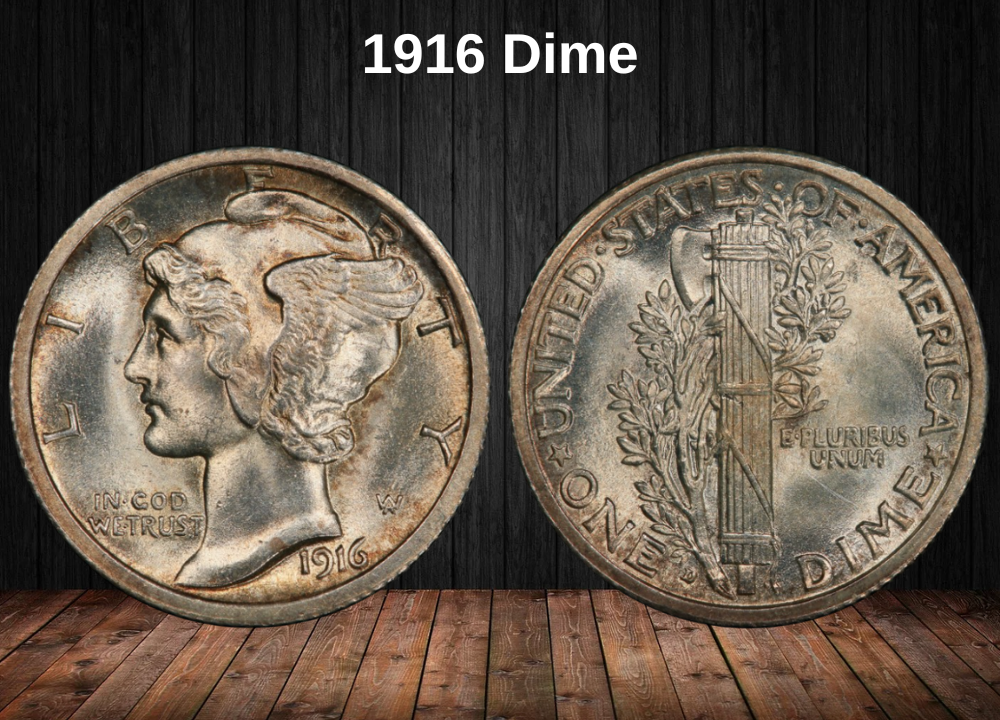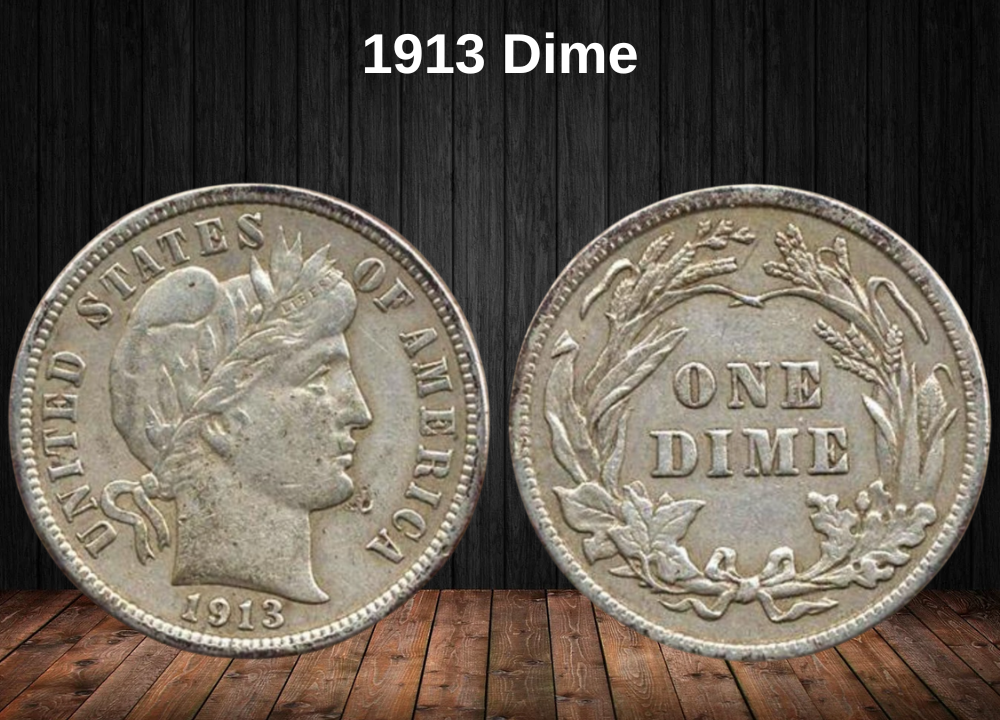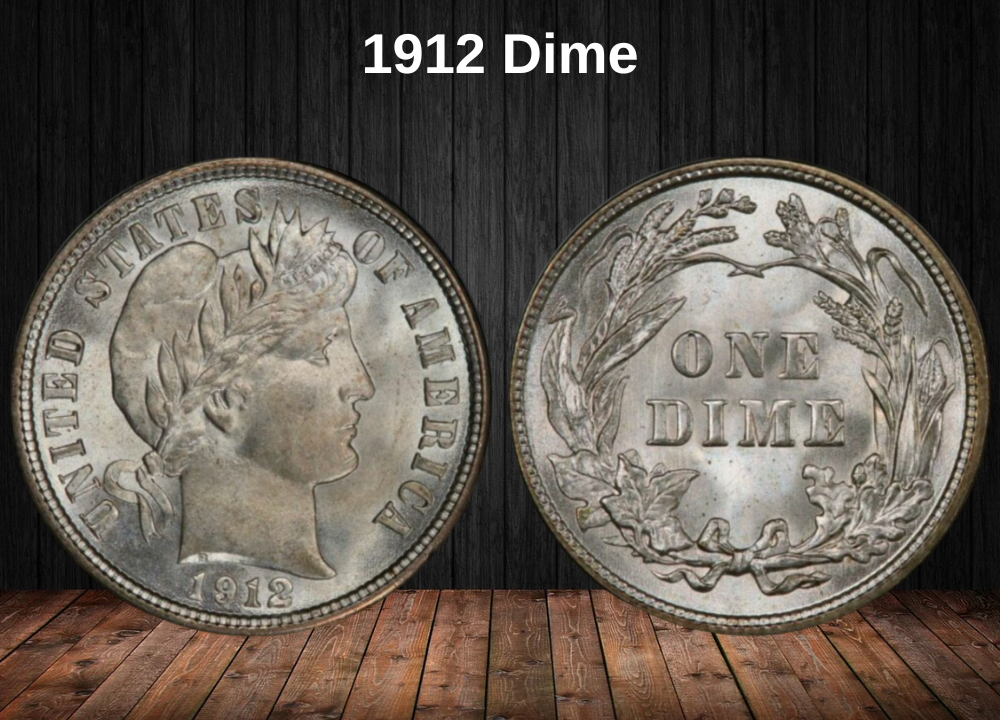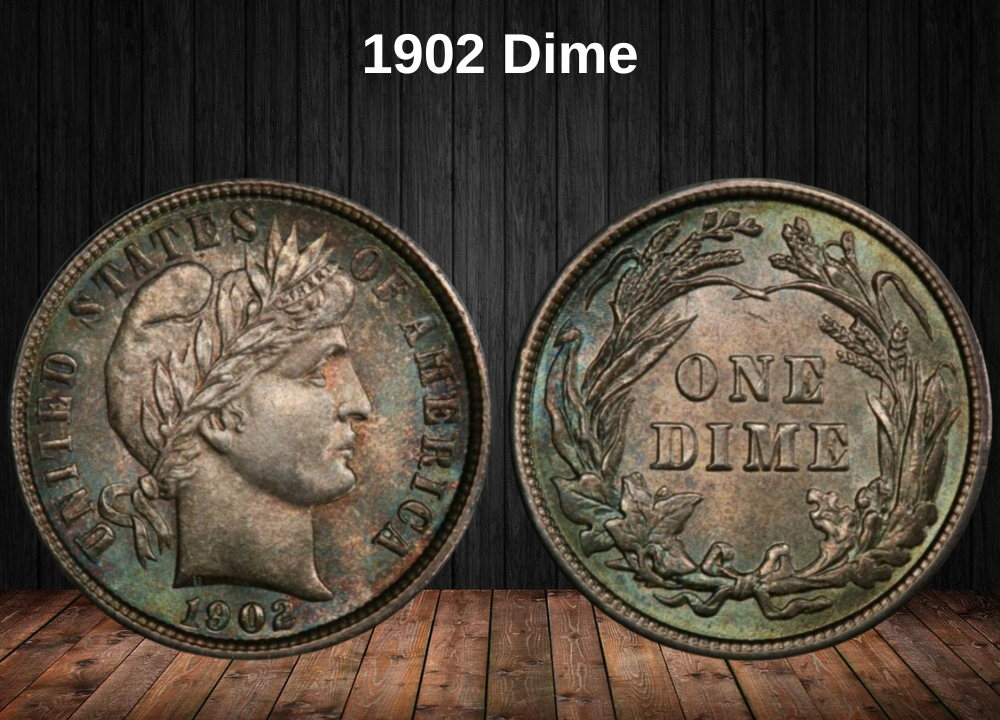Are you looking to add Roosevelt silver dimes to your collection? Or, maybe you’re considering selling your coins, hoping to make a good profit?
The 1964 Roosevelt dime is especially important because it was the last year the U.S. dime was struck in 90% silver for circulation. This makes it more desirable than later copper-nickel issues.
Even though Roosevelt dimes are not the most sought-after series, 1964 dimes in high grades, with Full Bands, or with errors can bring serious value. Proof and SMS (Special Mint Set) strikes add even more variety to this key year.
1964 Dime Value Chart
| Mint Mark | Good | Fine | Extremely Fine | Uncirculated (MS67) |
|---|---|---|---|---|
| 1964 No Mint Mark (P) Dime | $1.50–$3 (silver melt) | $3 | $3 | $50+ |
| 1964 “D” Dime | $1.50–$3 | $3 | $3 | $45+ |
| 1964 Proof Dime (Philadelphia) | – | – | – | $17+ |
| 1964 SMS Dime (Special Mint Set) | – | – | – | $11,500+ |
Note: All 1964 dimes have 90% silver content (2.25 g pure silver), so their minimum value will always be tied to silver spot prices.
History of the 1964 Dime
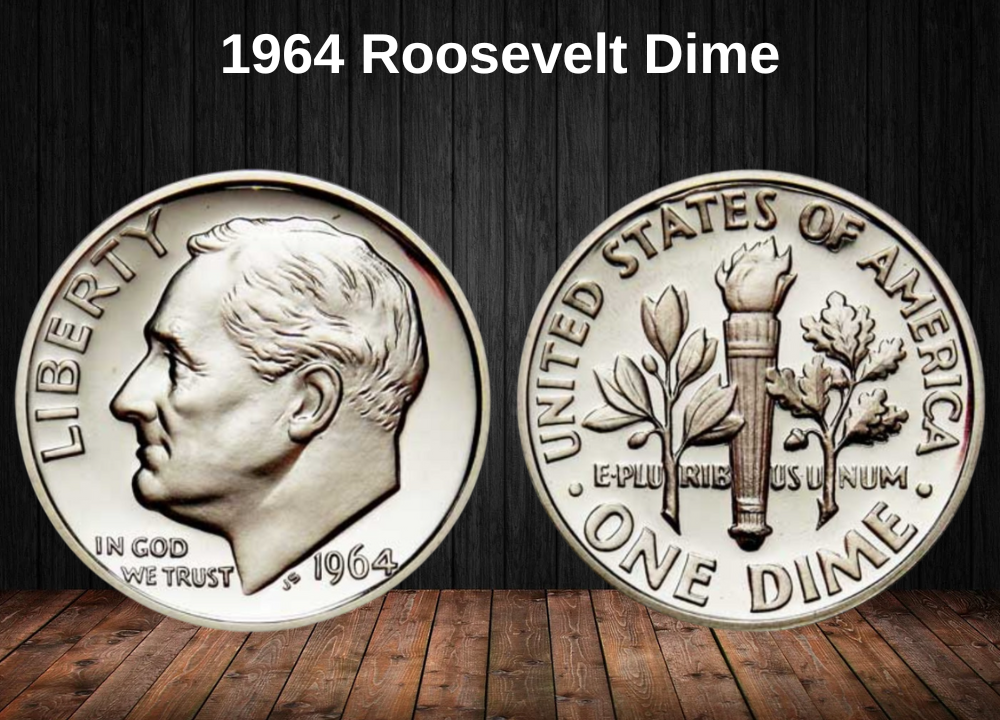
The 1964 dime belongs to the Roosevelt dime series, created to honor President Franklin Delano Roosevelt, one of the most admired leaders in U.S. history.
The choice of Roosevelt for the dime was strongly tied to the March of Dimes, a movement he founded to fight polio, the disease he personally battled throughout his life. After Roosevelt’s passing on April 12, 1945, Treasury Secretary Henry Morgenthau quickly approved the idea of a dime bearing his image.
The new dime was intended to replace the Mercury dime, which had been in circulation since 1916. In January 1946, the first Roosevelt dimes were struck and released into circulation, struck in 90% silver and 10% copper for durability.
The Silver Shortage of the 1960s
By the early 1960s, a serious silver shortage affected U.S. coinage. Many Americans began hoarding silver coins like dimes, quarters, and half dollars, either as investments or for their melt value.
To address this crisis, the U.S. Mint increased production in 1964, resulting in extremely high mintages. Despite this, the shortage persisted, and by mid-1965 the Treasury decided to eliminate silver from circulating dimes. Starting in 1965, Roosevelt dimes were struck in a copper core with a copper–nickel clad, a composition still used today.
The 1964 Date Freeze
Another unique aspect of the 1964 dime is the date freeze. To help with the transition away from silver, Congress authorized the Mint to continue striking dimes with the 1964 date well into 1966.
This means that although the dime carries the 1964 date, not all of them were actually struck in that year. This contributed to the enormous number of 1964-dated dimes minted — one of the highest in the Roosevelt dime series.
Features of the 1964 Roosevelt Dime
The 1964 dime marked the final year that Roosevelt dimes were struck in 90% silver, making it a significant piece in the series. Despite its high mintage, certain features and minting details make some examples especially valuable.
The Obverse of the 1964 Dime
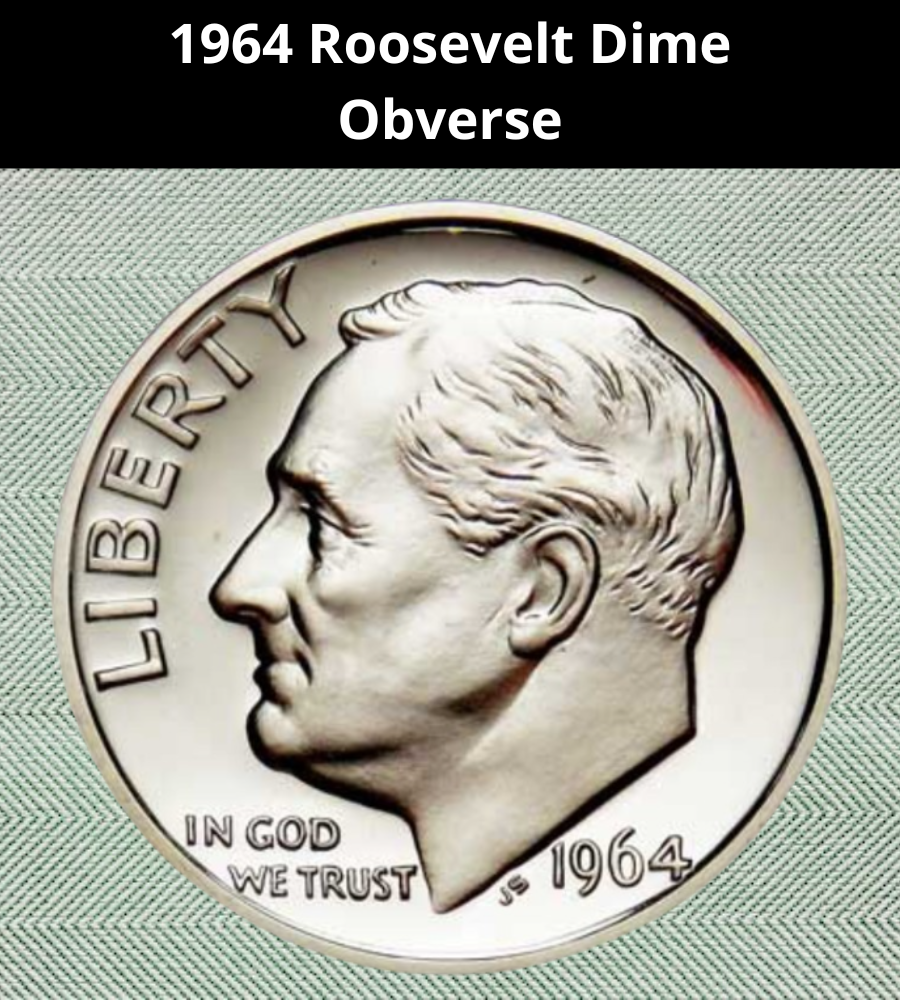
The obverse was designed by John R. Sinnock, Chief Engraver of the U.S. Mint. It shows a left-facing portrait of Franklin Delano Roosevelt, the 32nd president.
Key details include:
- LIBERTY inscribed along the left rim in front of Roosevelt’s profile.
- The motto IN GOD WE TRUST positioned beneath his chin.
- The date 1964 appearing to the right of the portrait.
- The designer’s initials JS at the base of Roosevelt’s neck — a detail that once sparked controversy, as some mistakenly believed it referenced Soviet dictator Joseph Stalin.
This simple yet dignified design has remained unchanged since its debut in 1946.
The Reverse of the 1964 Dime
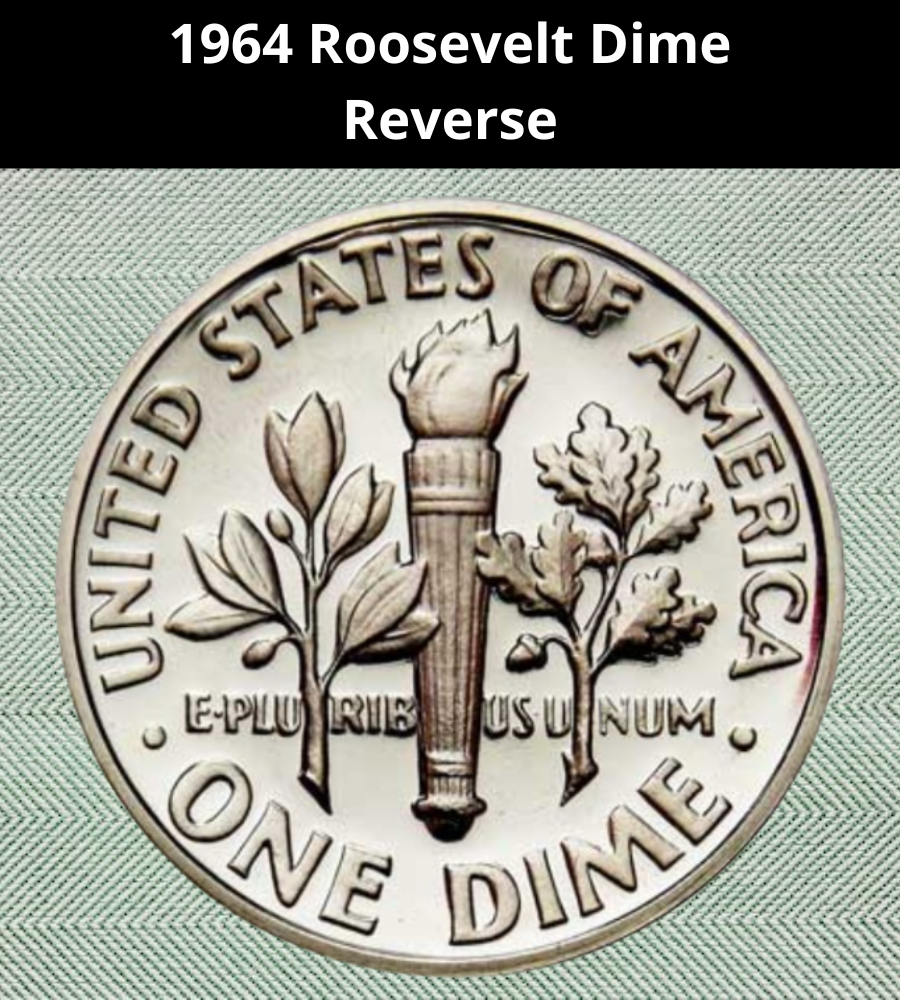
The reverse design combines three powerful national symbols:
- Torch – representing liberty.
- Olive branch – symbolizing peace.
- Oak branch – representing strength and independence.
Across the torch appears the motto E·PLURIBUS·UNUM (“Out of many, one”).
Other inscriptions include:
- UNITED STATES OF AMERICA at the top rim.
- ONE DIME along the lower rim.
One of the most important details for collectors is the bands on the torch. Coins with sharp, fully separated horizontal and vertical bands are graded as Full Bands (FB), and these often command higher premiums.
1964 Dime Specifications
| Detail | Specification |
|---|---|
| Face Value | $0.10 (Ten Cents) |
| Shape | Round |
| Edge | Reeded |
| Diameter | 17.90 mm (0.705 in) |
| Thickness | 1.35 mm (0.053 in) |
| Weight | 2.50 g |
| Composition | 90% Silver, 10% Copper |
| Silver Content | 2.25 g (0.0723 troy oz) |
1964 Dime Grading
| # | Grade |
|---|---|
| 1 | Basal State-1 |
| 2 | Fair |
| 3 | Very Fair |
| 4, 5, 6 | Good |
| 7, 8, 10 | Very Good |
| 12, 15 | Fine |
| 20, 30 | Very Fine |
| 40 | Extremely Fine |
| 50 | About Uncirculated |
| 60 | Mint State |
| 65 | Mint State |
| 70 | Mint State |
1964 Roosevelt Dime Value Guide
The 1964 Roosevelt dime holds a very special place in U.S. coinage history. It was the final year the dime was struck in 90% silver (10% copper), before the U.S. Mint transitioned to copper-nickel clad coinage in 1965.
With a staggering combined mintage of over 2 billion pieces from Philadelphia, Denver, and proof production, the 1964 dime remains the single highest-mintage date in the entire Roosevelt dime series. Yet, despite this enormous production, true gems are elusive—because when word spread that silver dimes were ending, the public began to hoard brand-new rolls and bags of these coins.
For collectors today, 1964 offers four distinct categories of interest:
1964 Philadelphia (No Mint Mark) Dime
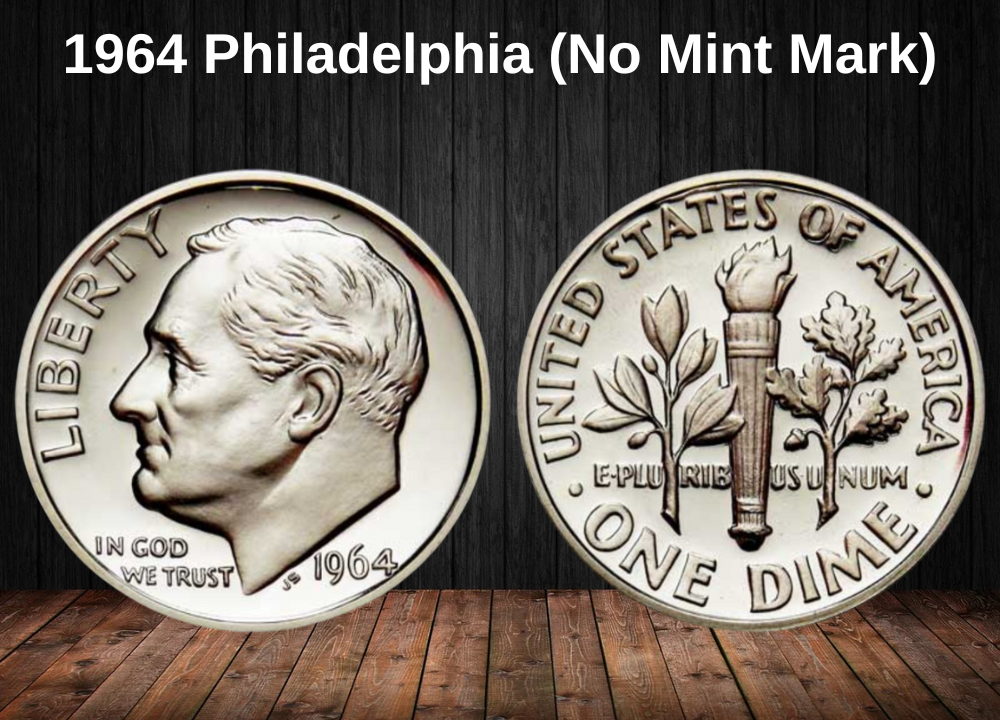
- Mintage: 929,360,000
- Mintmark: None (Philadelphia did not use a mintmark at the time).
At first glance, these coins may seem common, but the story changes when you consider condition. Circulated examples trade primarily for their silver value—around $2.65 at today’s silver prices.
However, in uncirculated condition, collectors begin to pay premiums:
- MS60: ~$4
- MS65: ~$15
- MS67: ~$200
Coins designated Full Bands (FB)—where the horizontal bands on the torch are fully separated and sharp—command significant demand.
- A MS67 FB example can exceed $1,000.
- The record auction for a Philadelphia dime was an MS67+ FB, sold for $2,350 (Heritage Auctions, 2017).
- Another high-end no-mintmark dime reached $1,495 in 2021 (PCGS online auction).
1964 Denver (D) Dime

- Mintage: 1,357,517,180 (the highest of any silver Roosevelt dime).
- Mintmark: “D” on the reverse.
The Denver issue was widely hoarded from the start, as collectors recognized the “last silver dime” significance. This makes circulated pieces just as common as Philadelphia’s, again worth about $2.65.
But in mint state, values grow with grade:
- MS62: ~$7
- MS65: $20–$30
- MS67: ~$45
Where the Denver dime shines is again in the Full Bands category:
- MS67 FB coins can sell for $1,000+.
- The ultimate rarity: a 1964-D MS68 FB, which shattered expectations at $8,000 in a Heritage Auction.
1964 Proof Dime (Philadelphia)
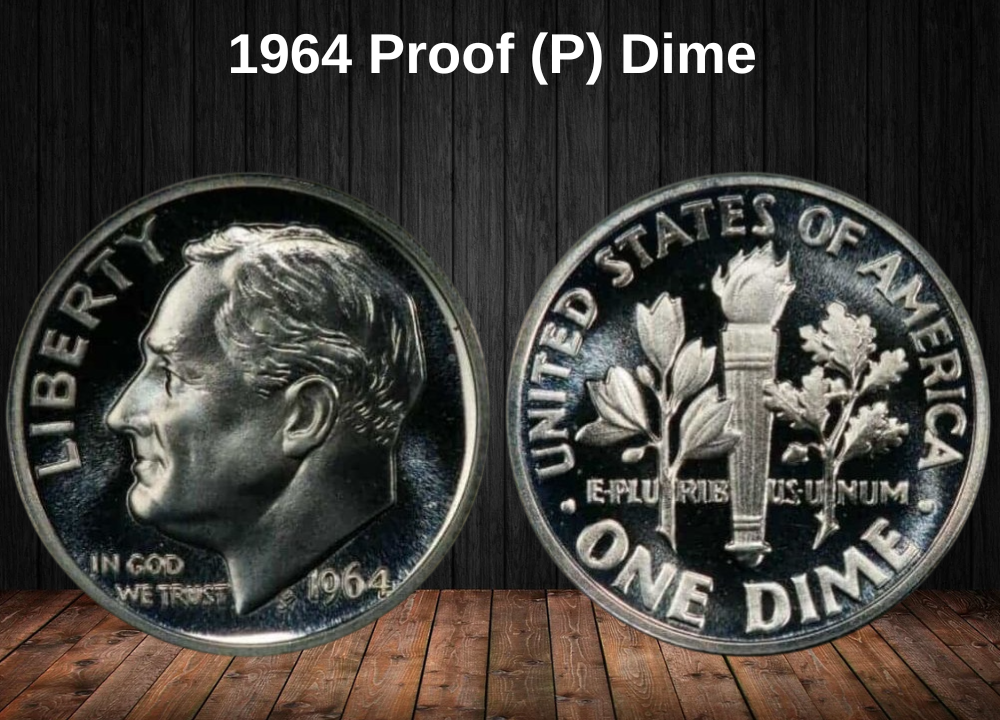
- Mintage: ~3,950,762 proofs.
- Mintmark: None (all proofs were struck in Philadelphia).
The Mint struck an unusually high number of proofs in 1964, making them easy to obtain today. Still, cameo contrast and top grades create strong premiums.
- PF63: ~$7
- PF64: ~$10
- PF69: $40–$75
- PF70: $250+
Cameo and Ultra Cameo pieces are where collectors compete:
- Cameo PF70: up to $650
- Ultra Cameo PF70: record of $5,250 (Heritage Auctions)
Collector’s note: 1964 is one of the most available dates for high-grade Roosevelt proofs, but cameo contrast examples are a true prize.
1964 SMS (Special Mint Set) Dime
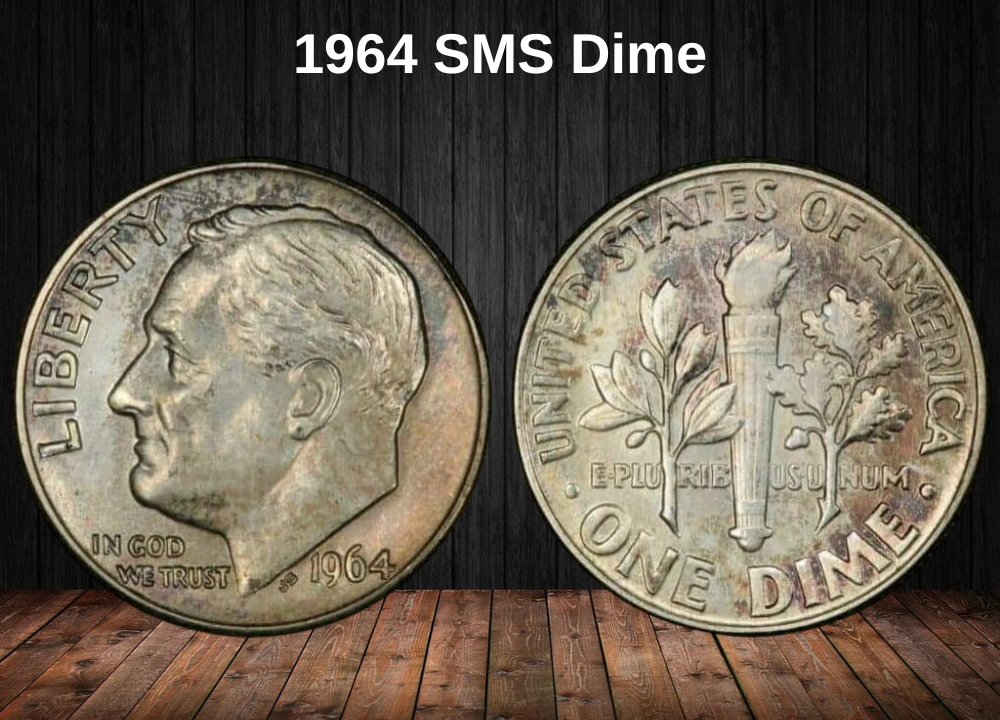
This is where the 1964 dime series reaches legendary status. In addition to proofs, the Mint also struck a mysterious Special Mint Set (SMS), believed to be experimental strikes for the 1965 SMS program.
Only 20 to 50 examples are believed to exist. Each displays distinctive satin-like surfaces and a sharper strike compared to regular issues.
Values:
- SP64: ~$4,000
- SP65–67: $7,000–$12,000
- SP68: up to $20,000
When a 1964 SMS dime appears at auction, it generates intense bidding and is considered one of the “holy grails” of modern U.S. coinage.
Rare 1964 Dime Error List
Minting errors are an exciting field for collectors, and the 1964 Roosevelt dime is no exception. With over 2 billion coins struck that year, errors were inevitable. Some of these mistakes, rather than being defects, have become coveted rarities that can command impressive premiums at auction.
Let’s explore the most notable 1964 dime errors that are worth adding to your collection:
1964 Reverse Die Cap Error
The die cap error occurs when a struck coin fails to eject properly from the press and is struck multiple times. Over time, the coin begins to wrap around the die, creating a bottle-cap-like appearance with raised, distorted rims.
- One 1964 Philadelphia dime (no mint mark), graded MS66 Full Bands, sold for $400.
- The fact that this piece combined a dramatic error with a Full Bands designation made it especially desirable to error specialists.
👉 Collector’s note: Die caps are highly visual errors, and the 1964 examples are scarce compared to other modern dimes.
1964 Struck-Through Edge Error
In this error, a fragment of the coin’s reeded edge breaks off during production and lands on top of the next blank planchet. When struck, the fragment leaves a dramatic imprint on the coin’s surface, known as a struck-through edge error.
- A 1964 dime with this error, graded AU58, was auctioned for $350.
👉 Collector’s note: Struck-throughs involving reeded edges are particularly interesting because they showcase the actual failure of the collar and striking system, making them more sought after than typical grease-filled die errors.
1964 Doubled Die Obverse Error
Among the most collectible errors on Roosevelt dimes is the doubled die. This occurs when a misaligned or worn hub impresses design elements twice, leaving doubled images. On 1964 dimes, doubling is often most visible on the date, LIBERTY, and the motto “IN GOD WE TRUST.”
- A Proof 1964 dime with a doubled die obverse, graded PF68, realized $1,100 at a 2019 auction.
- Circulation-strike examples are also known and can command strong prices, especially when the doubling is bold and dramatic.
👉 Collector’s note: Because of the massive mintage in 1964, doubled dies are not unexpected—but sharp, high-grade examples remain very collectible.
Where to Sell Your Dime Coin?
Now that you know the value of your dime, the next step is deciding where to sell it. There are several trusted options—both online and in person—that can help you get the best price depending on your coin’s rarity and condition.
To see the full list of recommended places, along with their advantages and disadvantages, check our complete guide on where to sell your dime coins.
FAQ about the 1964 Roosevelt Dime
1. Why is the 1964 Roosevelt dime considered historically significant?
The 1964 dime marks the final year of 90% silver coinage for the Roosevelt dime series. Starting in 1965, the U.S. Mint transitioned to copper-nickel clad dimes due to rising silver prices. This change makes the 1964 dime a symbolic end of America’s circulating silver coinage era, and collectors often see it as a pivotal date.
2. How can I tell if my 1964 dime was minted in Philadelphia or Denver?
Philadelphia dimes from 1964 have no mint mark, while Denver issues carry a small “D” mint mark on the reverse, next to the torch. Both are common, but Denver coins were more heavily hoarded in mint state.
3. What is the difference between Full Bands and regular strike 1964 dimes?
“Full Bands (FB)” refers to a sharp strike on the torch on the reverse of the dime. A Full Bands coin shows complete separation of the horizontal lines around the torch, indicating strong die pressure and an exceptional strike. Collectors prize these coins, and they can be worth hundreds or even thousands of dollars in high grades.
4. Are proof dimes from 1964 valuable?
Yes. Nearly 4 million proof dimes were struck at the Philadelphia Mint. Standard proofs are inexpensive, often under $20 in lower grades. However, Cameo and Ultra Cameo proofs—with deep frosted devices and mirror-like fields—can fetch much higher premiums. A 1964 Ultra Cameo proof graded PF70 once sold for over $5,000.
5. What makes the 1964 SMS dime so rare?
The 1964 SMS (Special Mint Set) dime is an experimental strike, possibly a trial for the SMS coins of 1965. Fewer than 50 examples are believed to exist today. They feature a satin-like finish and are distinct from both circulation and proof strikes. At auction, these coins have realized between $4,000 and $20,000, making them one of the great rarities of modern U.S. coinage.
6. What are the most notable minting errors on the 1964 dime?
The 1964 dime series produced several collectible errors, including:
- Reverse die caps, which can look like bottle caps.
- Struck-through errors, where debris or broken edge reeds are impressed onto the coin.
- Doubled die obverses, often visible on “IN GOD WE TRUST” and the date.
Such errors can range in value from a few hundred dollars to well over $1,000, depending on rarity and grade.
7. Is it worth saving circulated 1964 dimes?
Yes, but mainly for their silver content. Each 1964 dime contains about 0.07234 troy ounces of silver, making it worth roughly $2.65 at current silver prices. While common circulated coins don’t carry much collector premium, they remain a safe way to hold “junk silver” and are always of interest to bullion investors and coin collectors alike.


